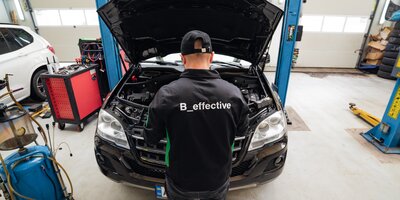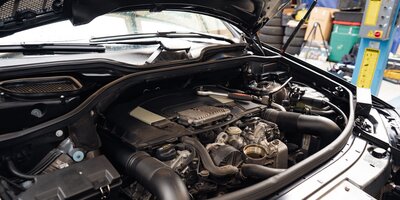TBN, What’s in It for Me?
Modern motor oils are high-tech products required to meet stringent specifications regarding their physicochemical properties and actual performance. Where the physicochemical properties are concerned, one should first of all mention viscosity – or to be more accurate, several viscosity parameters, mandated by the SAE J300 classification system, including kinematic viscosity readings at 40°C and 100°C, cold cranking viscosity (CCS) at -35°C for 0W, -30°C for 5W, -25°C for 10W, -20°C for 15W and -15°C for 20W grades, and high temperature high shear viscosity (HTHS) at 150°C. The second important parameter is Noack volatility, describing oil tendency to evaporate at elevated temperatures. Then there is the total base number, or TBN, referring to the alkalinity reserve in the oil.

The alkalinity buffer serves to neutralize acids generated by various oxidation processes, notably fuel combustion, especially when a low-quality high-sulfur fuel is used, and oil oxidation. The amount of acids in the oil is described by another number, known as total acid number, TAN, measured according to ASTM D 664. As oil ages, the TBN gradually falls as the TAN increases. At some point, dubbed as TBN/TAN crossover, they become equal. At this point, corrosion protection of the engine gets badly compromised and the oil needs to be changed. Unless extremely bad fuel is used and recommended oil exchange interval is followed, you are unlikely to ever encounter TBN/TAN crossover in practice. In most cases, the primary reason for changing the oil is particle contamination and not acidity.
Nonetheless, in an attempt to differentiate their products from competitors, some lubricant companies start to “compete” for a higher TBN: the higher the TBN the better. This article explains when high a TBN is good and when it isn’t. The following simple scheme is to help you assess your needs for passenger cars:
• Older diesel powered car without diesel particulate filters (DPF), using low-quality or contaminated fuel: the recommended TBN range is 10-12 mg KOH / g.
• Newer diesel-powered vehicles with diesel particulate filters (DPF), running on ultralow sulfur diesel (ULSD): the recommended TBN range is 6 to 9 mg KOH/g.
Use of biofuel may also justify choosing an oil with a higher TBN. The problem is that crankcase lubricant is always to some extent “diluted” by fuel, especially during short trips, when engine fails to warm up properly, or at high speeds, when a rich fuel-to-air mixture is used to cool the engine. The dilution of motor oil with a conventional petroleum-based fuel will cause a viscosity drop, but doesn’t significantly affect oxidation stability of the oil. However, the dilution of motor oil with biofuel undermines the oxidation stability of the oil.
Gasoline, LPG and CNG powered vehicles do not require high TBN; it fact, a high TBN level is likely to be detrimental for them, causing ash deposits build-up and adversely affecting exhaust after-treatment systems (GPF, TWC). Using a high-TBN heavy-duty diesel oil (HDDO) in a new heavily boosted gasoline engine may trigger a nasty super-knock, known as low-speed pre-ignition (LSPI), which can entirely ruin the engine.
Acceptable TBN limits are regulated by ACEA and numerous national engine oil standards. Keep in mind, that there are different laboratory procedures for TBN determination, ASTM D 2896 and ASTM D 4739 being the commonest. The ACEA classification mandates use of ASTM D 2896, which effectively quantifies both strong and weak bases in the formulation and tends to return a higher TBN reading than ASTM D 4739.
The main TBN contributors in a motor oil are overbased detergents, including but not limited to sulfonates, phenates and salicylates of calcium, and sometimes, sodium and magnesium. One should realize, however, that it is not only the actual TBN value that matters but also which additives were deployed in the formulation to achieve the said value. For instance, highly overbased sulfonates allow easy TBN boosting. However, they neutralize both most harmful strong acids and less harmful weak acids, and hence, the alkaline buffer tends to be quickly depleted. Furthermore, highly overbased sulfonates lack the detergency effect which can be provided by low-overbased polymeric sulfonates and ashless dispersants. However, the latter tend to be less efficient TBN boosters! Partial replacement of calcium detergent with sodium detergent was reported to reduce the risk of LSPI. Stronger alkali contained in overbased sodium detergents are believed to be also more effective in handling biodiesel contamination. Once again, development of a balanced formulation requires a great deal of experience in order to meet required performance specifications, at the minimum possible cost.
The API Engine Oil Classification does not explicitly regulate TBN level, relying instead upon ASTM D 6557 ball rust test to evaluate corrosion preventative characteristics of oils. This is easily understandable since the majority of US automotive fleet uses gasoline rather than diesel. As heavy-duty applications are concerned, it is believed that oils with inadequate detergency and corrosion protection will likely fail one or another engine test mandated by the API Classification, for instance, filter pressure head and sludge limits in Cummins M11 (ASTM D 6838) test or top groove fill limit in Caterpillar 1K (ASTM D 6750) test, and hence will be screened out. Since the level of sulfur in diesel fuel has been reduced, modern CJ-4, CK-4 and FA-4 engine oils start out with a lower TBN then previous API classes such as CI-4 and CH-4. Condemning limits for in-service oil have also been reduced. Furthermore, some industry representatives in general question the relevance of the TBN for motor oils!
Technically speaking, it isn’t always so important how high the TBN starts out for fresh oil, but rather how quickly it declines in service due the alkalinity reserve depletion. In general, ACEA specifications are more stringent than API specifications. The following scheme is to help you assess your TBN level needs for heavy-duty trucks:
• When using high sulfur diesel fuel: the recommended TBN range is 12-15 mg KOH/g; go for ACEA E4 or E7, or API CH-4 or CI-4 HDDO. When you are forced to use a bad fuel, it doesn’t really matter if you use an old or a new truck: when you have to choose between engine longevity and exhaust after-treatment system longevity, the former is more important.
• New trucks with EGR engines, fitted with SCR NOx reduction systems and particulate filters, using ULSD diesel fuel: the recommended TBN range is 7 to 9 mg KOH/g. Go for ACEA E6, E9 or API CJ-4, CK-4 or FA-4, as recommended by engine manufacturers.
API CK-4 and ACEA E9 are the preferred choice for engines meeting Euro VI emission requirements. The API FA-4 category covers certain xW-30 oils with reduced HTHS viscosity (2.9 to 3.2 cP) which are only compatible with certain new high-speed four-stroke cycle diesel engines meeting 2017 model year on-highway greenhouse gas (GHG) emission standards. API FA-4 oils should never be used in any other engines; if in doubt, go for API CK-4 or ACEA E6 or E9 as safer alternatives.
Due to their top-tier full synthetic formulas using purpose-fit detergent-inhibitor packages, all BIZOL motor oils demonstrate outstanding oxidation stability and TBN retention, providing excellent long-term protection against corrosion even under most severe conditions.

You might also like

The modern marvel of an internal combustion motor powers our vehicles, providing the strength and reliability we rely on for daily transportation. However, just like anything else subjected to constant use, motorized units experience wear and tear over time. Component deterioration can significantly impact performance and longevity. In this article, we will delve into the intricacies of engine wear meaning, explore the various causes behind it, provide actionable tips to reduce and prevent it. Furthermore, we will look at how specialized engine oils, such as BIZOL, play a crucial role in safeguarding your engine’s health. Let’s begin by understanding what engine wear is and the factors that contribute to it.

The melodious purr of a motor, the velvety transition of cog-wheel, and the elegant voyage along the expansive highway — these are the unmistakable characteristics of a meticulously calibrated self-shifting gearbox system. But what transpires when the motorized ensemble falters, the cogs gnash, and the voyage veers into an unforeseen tempest? Get into the realm of automatic transmission problems, a domain where automotive aficionados and everyday motorists alike encounter the enigmatic intricacies of this complex system.

Driving is a blend of exhilaration and convenience, but sometimes, your trusty car can hit a snag. One of the most frustrating issues is a coolant leak.
Coolant, often referred to as the versatile 'antifreeze,' assumes the uncelebrated role of an automotive guardian, ensuring your engine's harmonious operation. This unassuming fluid stands as a bulwark against the scorching summer heat and the bone-chilling cold of winter. Nevertheless, when the vigilance of antifreeze wanes, and it embarks on an unauthorized journey beyond its confines, ominous troubles come into view.

